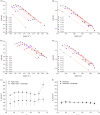Facemasks and ferrous metallurgy: improving gasification reactivity of low-volatile coals using waste COVID-19 facemasks for ironmaking application
- PMID: 35177739
- PMCID: PMC8854564
- DOI: 10.1038/s41598-022-06691-w
Facemasks and ferrous metallurgy: improving gasification reactivity of low-volatile coals using waste COVID-19 facemasks for ironmaking application
Abstract
The global pandemic response to COVID-19 has led to the generation of huge volumes of unrecyclable plastic waste from single use disposable face coverings. Rotary hearth furnaces can be used to recover Zn and Fe from non-recyclable steelmaking by-product dusts, and waste plastic material such as facemasks could be utilized as a supplementary reductant for the rotary hearth furnace (RHF), but their fibrous form makes milling and processing to appropriate sizing for RHF application extremely challenging. A scalable method of grinding facemasks to powder by melting and mixing with Welsh coal dust reported herein provides a solution to both environmental challenges. The melt-blended PPE/coal dust shows a dramatically improved CO2 gasification reactivity (Ea = 133-159 kJmol-1) when compared to the untreated coal (Ea = 183-246 kJmol-1), because of improved pore development in the coal during the pyrolysis stage of heating and the catalytic activity of the CaO based ash present in the facemask plastic. The results are promising for the application of waste facemasks in recycling steelmaking by-product dusts in rotary hearth furnaces and may also be suitable for direct injection to the blast furnace subject to further study.
© 2022. The Author(s).
Conflict of interest statement
The authors declare no competing interests.
Figures







Similar articles
-
The effect of recycled plastics and cooking oil on coke quality.Waste Manag. 2017 Mar;61:269-275. doi: 10.1016/j.wasman.2016.08.039. Epub 2016 Sep 19. Waste Manag. 2017. PMID: 27659866
-
Recycling facemasks into civil construction material to manage waste generated during COVID-19.Environ Sci Pollut Res Int. 2024 Feb;31(8):12577-12590. doi: 10.1007/s11356-023-31726-8. Epub 2024 Jan 3. Environ Sci Pollut Res Int. 2024. PMID: 38168852
-
Co-gasification of blast furnace dust with petcoke for sustainable waste management.Waste Manag. 2025 Feb 1;193:506-516. doi: 10.1016/j.wasman.2024.12.027. Epub 2024 Dec 31. Waste Manag. 2025. PMID: 39742585
-
Key ingredients and recycling strategy of personal protective equipment (PPE): Towards sustainable solution for the COVID-19 like pandemics.J Environ Chem Eng. 2021 Oct;9(5):106284. doi: 10.1016/j.jece.2021.106284. Epub 2021 Aug 30. J Environ Chem Eng. 2021. PMID: 34485055 Free PMC article. Review.
-
Recycling and management of waste lead-acid batteries: A mini-review.Waste Manag Res. 2016 Apr;34(4):298-306. doi: 10.1177/0734242X16633773. Epub 2016 Mar 3. Waste Manag Res. 2016. PMID: 26941209 Review.
Cited by
-
Valorization of discarded face mask for bioactive compound synthesis and photodegradation of dye.Environ Res. 2022 Oct;213:113737. doi: 10.1016/j.envres.2022.113737. Epub 2022 Jun 23. Environ Res. 2022. PMID: 35752328 Free PMC article.
-
Upcycling of face masks to application-rich multi- and single-walled carbon nanotubes.Carbon Lett (Korean Carbon Soc). 2022;32(7):1681-1688. doi: 10.1007/s42823-022-00398-8. Epub 2022 Sep 30. Carbon Lett (Korean Carbon Soc). 2022. PMID: 40477995 Free PMC article.
References
-
- Lyu W, Wehby GL. Community use of face masks and COVID-19: Evidence from a natural experiment of state mandates in the US. Health Aff. 2020;39:1419–1425. - PubMed
-
- UK Department of Health & Social Care. Face Coverings: When to Wear One, Exemptions, and how to make your own. (2020). https://www.gov.uk/government/publications/face-coverings-when-to-wear-o....
-
- North London Waste Authority. 102 Million disposable facemasks thrown away in the UK each week would cover Wembley pitch 232 times over. (2020). https://www.nlwa.gov.uk/news/102-million-disposable-facemasks-thrown-awa....
-
- Wang M-W, et al. Mask crisis during the COVID-19 outbreak. Eur. Rev. Med. Pharmacol. Sci. 2020;24:3397–3399. - PubMed
Publication types
MeSH terms
LinkOut - more resources
Full Text Sources
Research Materials
Miscellaneous

